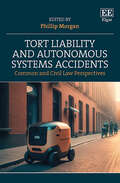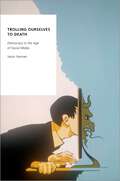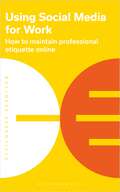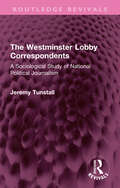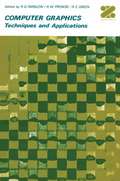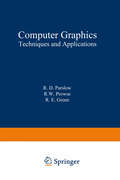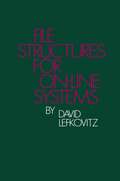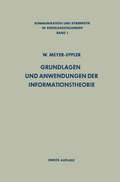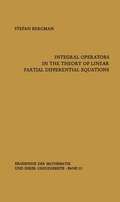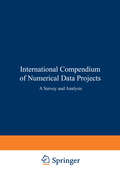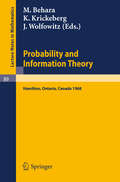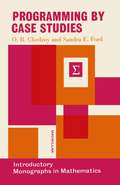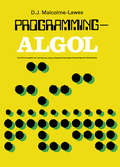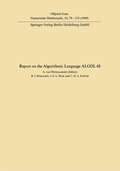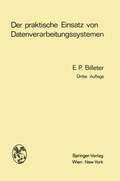- Table View
- List View
TinyML Cookbook: Combine machine learning with microcontrollers to solve real-world problems
by Gian IodiceOver 70 recipes to help you develop smart applications on Arduino Nano 33 BLE Sense, Raspberry Pi Pico, and SparkFun RedBoard Artemis Nano using the power of machine learning Purchase of the print or Kindle book includes a free eBook in PDF format.Key FeaturesOver 20+ new recipes, including recognizing music genres and detecting objects in a sceneRun on-device ML with TensorFlow Lite for Microcontrollers, Edge Impulse, TVM, and scikit-learnExplore cutting-edge technologies, such as on-device training for updating models without data leaving the deviceBook DescriptionDiscover the incredible world of tiny Machine Learning (tinyML) and create smart projects using real-world data sensors with the Arduino Nano 33 BLE Sense, Raspberry Pi Pico, and SparkFun RedBoard Artemis Nano. TinyML Cookbook, Second Edition, will show you how to build unique end-to-end ML applications using temperature, humidity, vision, audio, and accelerometer sensors in different scenarios. These projects will equip you with the knowledge and skills to bring intelligence to microcontrollers. You'll train custom models from weather prediction to real-time speech recognition using TensorFlow and Edge Impulse. Expert tips will help you squeeze ML models into tight memory budgets and accelerate performance using CMSIS-DSP. This improved edition includes new recipes featuring an LSTM neural network to recognize music genres and the Faster-Objects-More-Objects (FOMO) algorithm for detecting objects in a scene. Furthermore, you'll take your tinyML solutions to the next level with microTVM, microNPU, scikit-learn, and on-device learning. This book will help you stay up to date with the latest developments in the tinyML community and give you the knowledge to build unique projects with microcontrollers!What you will learnUnderstand the microcontroller programming fundamentalsWork with real-world sensors, such as the microphone, camera, and accelerometerImplement an app that responds to human voice or recognizes music genresLeverage transfer learning with FOMO and KerasLearn best practices on how to use the CMSIS-DSP libraryCreate a gesture-recognition app to build a remote controlDesign a CIFAR-10 model for memory-constrained microcontrollersTrain a neural network on microcontrollersWho this book is forThis book is ideal for machine learning engineers or data scientists looking to build embedded/edge ML applications and IoT developers who want to add machine learning capabilities to their devices. If you’re an engineer, student, or hobbyist interested in exploring tinyML, then this book is your perfect companion. Basic familiarity with C/C++ and Python programming is a prerequisite; however, no prior knowledge of microcontrollers is necessary to get started with this book.
Topics in Applied Quantumelectrodynamics
by Paul UrbanThese lectures represent a condensation of a number of colloquia, seminars and discussions held at the Institute of Theoretical Physics of the University of Graz during the last years and epitomize the principal lines of research undertaken by my group. From the very beginning of my appointment at the University of Graz in 1947 I have been concerned with the task of bringing up a relatively small group of scientifically interested and open-minded co-workers and of stimulating them to sound scientific research. Since 1930 I myself have dealt with subjects of the kind treated in these lectures, to which I was introduced by my late friend and teacher TH. SEXL. But also as assistant and co-worker of E. FUES and R. THIRRING I frequently worked on these problems, constantly using new methods and lines of approach. During the last years of the war and the first ones afterwards Ihad the fortunate opportunity to receive many stimulating ideas and comments on my work from A. SOMMERFELD on the occasion of my frequent visits to Munich. Especially this last period, although partially connected with personal difficulties and troubles of many kinds stemming from the turbulence of lost-war readjustments, I consider to be one of the most valuable times in my life.
Tort Liability and Autonomous Systems Accidents: Common and Civil Law Perspectives
Autonomous systems driven by artificial intelligence (AI) technologies have significant potential for increased productivity and improved safety in many sectors, but it is inevitable that some accidents will occur. The law needs an adequate way to respond to these scenarios and compensate those wrongfully injured. This comprehensive book examines the unique difficulties that autonomous systems create for existing accident compensation systems founded on tort, and proposes solutions.Its chapters question the adequacy of accident compensation systems designed around the human wrongdoer, or a human whose conduct can be attributed to a legal person, when the 'wrongdoer' is an autonomous system. With a multi-jurisdictional approach, including both common and civil law perspectives, this book examines the many challenges that autonomous systems present in tort law and sets forth that tort lawyers will need to significantly adjust their thinking to face these challenges. Focus is given to proposals and developments at an EU level and finding solutions to the problems brought about by autonomous systems.This insightful text will be of great value to both students, researchers and practitioners in tort law, accident compensation and AI. High tech companies, think tanks, consultancies and organisations interested in autonomous systems and accidents will also widely benefit from its expertise.
Training Systems using Python Statistical Modeling: Explore Popular Techniques For Modeling Your Data In Python
by Curtis MillerThis book will acquaint you with various aspects of statistical analysis in Python. You will work with different types of prediction models, such as decision trees, random forests and neural networks. By the end of this book, you will be confident in using various Python packages to train your own models for effective machine learning.
Trolling Ourselves to Death: Democracy in the Age of Social Media (Oxford Studies in Digital Politics)
by Jason HannanAlmost forty years ago, Neil Postman argued that television had brought about a fundamental transformation to democracy. By turning entertainment into our supreme ideology, television had recreated public discourse in its image and converted democracy into show business. In Trolling Ourselves to Death, Jason Hannan builds on Postman's classic thesis, arguing that we are now not so much amusing, as trolling ourselves to death. Yet, how do we explain this profound change? What are the primary drivers behind the deterioration of civic culture and the toxification of public discourse? Trolling Ourselves to Death moves beyond the familiar picture of trolling by recasting it in a broader historical light. Contrary to the popular view of the troll as an exclusively anonymous online prankster who hides behind a clever avatar and screen name, Hannan asserts that trolls have emerged from the cave, so to speak, and now walk in the clear light of day. Trolls now include politicians, performers, patriots, and protesters. What was once a mysterious phenomenon limited to the darker corners of the Internet has since gone mainstream, eroding our public culture and changing the rules of democratic politics. Hannan shows how trolling is the logical outcome of a culture of possessive individualism, widespread alienation, mass distrust, and rampant paranoia. Synthesizing media ecology with historical materialism, he explores the disturbing rise of political unreason in the form of mass trolling and sheds light on the proliferation of disinformation, conspiracy theory, "cancel culture," and digital violence. Taking inspiration from Robert Brandom's innovative reading of Georg Wilhelm Friedrich Hegel, Trolling Ourselves to Death makes a case for building "a spirit of trust" to curb the epidemic of mass distrust that feeds the plague of political trolling.
Understanding Initial Coin Offerings: A New Era of Decentralized Finance (Understanding series)
by Dmitri BoreikoDelving into the comprehensive evolution of Initial Coin Offerings (ICOs), this innovative book traces their origins and transition into modern forms such as Security Token Offerings, Initial Exchange Offerings, Initial DEX Offerings and Non-Fungible Tokens. It provides an in-depth analysis of the factors behind the appeal of ICOs, the complex ecosystem surrounding them, and the key developments within the blockchain and cryptocurrency space.Countering common misconceptions such as equating ICOs with fraud, Dmitri Boreiko emphasizes the need for robust regulation in the field. Chapters explore the economics of ICOs, offer practical research guidance and navigate the complexities of ICO regulation. The book concludes by highlighting emerging mechanisms in blockchain fundraising, focusing on the increased security, transparency, and flexibility of newer mechanisms.Concise and incisive, this is a timely read for economics students focusing on ICOs and blockchain applications, as well as fintech more broadly. Written in an accessible style, blockchain practitioners, investors and entrepreneurs, and start-ups in tech will also find this to be an interesting read.
Unity 2020 Mobile Game Development: Discover Practical Techniques And Examples To Create And Deliver Engaging Games For Android And Ios, 2nd Edition
by John DoranUnlocking the Secrets of Prompt Engineering: Master the art of creative language generation to accelerate your journey from novice to pro
by Gilbert MizrahiEnhance your writing with AI by mastering prompt engineering techniques and become an expert in developing and utilizing LLM prompts across applicationsKey FeaturesMaster prompt engineering techniques to harness AI's writing potentialDiscover diverse LLM applications for content creation and beyondLearn through practical examples, use cases, and hands-on guidancePurchase of the print or Kindle book includes a free PDF eBookBook DescriptionUnlocking the Secrets of Prompt Engineering is your key to mastering the art of AI-driven writing. This book propels you into the world of large language models (LLMs), empowering you to create and apply prompts effectively for diverse applications, from revolutionizing content creation and chatbots to coding assistance. Starting with the fundamentals of prompt engineering, this guide provides a solid foundation in LLM prompts, their components, and applications. Through practical examples and use cases, you'll discover how LLMs can be used for generating product descriptions, personalized emails, social media posts, and even creative writing projects like fiction and poetry. The book covers advanced use cases such as creating and promoting podcasts, integrating LLMs with other tools, and using AI for chatbot development. But that’s not all. You'll also delve into the ethical considerations, best practices, and limitations of using LLM prompts as you experiment and optimize your approach for best results. By the end of this book, you'll have unlocked the full potential of AI in writing and content creation to generate ideas, overcome writer's block, boost productivity, and improve communication skills.What you will learnExplore the different types of prompts, their strengths, and weaknessesUnderstand the AI agent's knowledge and mental modelEnhance your creative writing with AI insights for fiction and poetryDevelop advanced skills in AI chatbot creation and deploymentDiscover how AI will transform industries such as education, legal, and othersIntegrate LLMs with various tools to boost productivityUnderstand AI ethics and best practices, and navigate limitations effectivelyExperiment and optimize AI techniques for best resultsWho this book is forThis book is for a wide audience, including writers, marketing and business professionals, researchers, students, tech enthusiasts, and creative individuals. Anyone looking for strategies and examples for using AI co-writing tools like ChatGPT effectively in domains such as content creation, drafting emails, and inspiring artistic works, will find this book especially useful. If you are interested in AI, NLP, and innovative software for personal or professional use, this is the book for you.
Using Social Media for work: How to maintain professional etiquette online (Business Essentials)
by Bloomsbury PublishingEssential reading for anyone who has to work with social media in a professional capacity, from using networking sites to marketing their businesses or employers.Many people use social media every day - and it can be a vital tool in professional life. Whether you're polishing an online CV, contributing to a chat group relating to your industry sector, or using Instagram to highlight goods and services, the professional face you present needs to be strategically different to the 'social' posts that you may make outside of work. Using Social Media at Work is an easy to read, pocket-sized guide that can be dipped into for advice, tips and guidance - perfect for reading in a lunch break or on a commute. It is the ultimate etiquette guide for anyone nervous about using social media in professional settings, including: top tips, common mistakes and advice on how to avoid them, summaries of key points, and lists of the best sources of further help.
Visual Basic Quickstart Guide: Improve your programming skills and design applications that range from basic utilities to complex software
by Aspen OlmstedMaster software development with Visual Basic, from core concepts to real-world applications, with this comprehensive guideKey FeaturesAcquire a solid understanding of object-oriented programming (OOP) principles, such as inheritance and polymorphismDevelop expertise in maintaining legacy code with increased efficiencyLearn to read, write, and differentiate between VB Script, VBA, VB Classic, or and VB.NET CodePurchase of the print or Kindle book includes a free PDF eBookBook DescriptionWhether you’re an absolute beginner or an experienced developer looking to learn the Visual Basic language, this book takes a hands-on approach to guide you through the process. From the very first chapters, you'll delve into writing programs, exploring core concepts such as data types, decision branching, and iteration. Additionally, you’ll get to grips with working with data structures, file I/O, and essential object-oriented principles like inheritance and polymorphism. This book goes beyond the basics to equip you with the skills to read and write code across the entire VB family, spanning VB Script, VBA, VB Classic, and VB.NET, enabling you to handle legacy code maintenance with ease. With clear explanations, practical examples, and hands-on exercises, this book empowers you to tackle real-world software development tasks, whether you're enhancing existing projects or embarking on new ones. It addresses common challenges like distinguishing between the variations of the VB programming language to help you choose the right one for your projects. Don't let VB's extensive legacy daunt you; embrace it with this comprehensive guide that equips you with practical, up-to-date coding skills to overcome the challenges presented by Visual Basic's rich history of over two decades.What you will learnAcquire a solid understanding of object-oriented programming (OOP) principles, such as inheritance and polymorphismDevelop expertise in maintaining legacy code with increased efficiencyLearn to read, write, and differentiate between Visual Baic Script, Visual Baic for Applications, Visual Baic Classic, and VB.NET CodePurchase of the print or Kindle book includes a free PDF e-bookWho this book is forIf you’re a software developer or web developer either already engaged in or aspiring to be involved in maintaining, enhancing, administering, and defending visual basic programs, websites, and scripts, this book is for you. It's an excellent resource for beginners in software development who want to learn Visual Basic from scratch.
The Westminster Lobby Correspondents: A Sociological Study of National Political Journalism (Routledge Revivals)
by Jeremy TunstallThe Westminster Lobby correspondents have a special place in both the politics and the mass media of Britain. These journalists dominate the behind-the-scenes reporting of British national politics. In this book, originally published in 1970, Jeremy Tunstall presents the first systematic social science study of the uniquely British phenomenon of Lobby correspondents.The study includes data collected from interviews with the national Lobby correspondents, who also completed lengthy questionnaires. It contains evidence of their careers, political opinions, pay, working conditions, relationships with their employing news organization and political news sources, and on the way in which the correspondents both compete with, and exchange information with, each other. As well as this fascinating empirical data, the book offers an important contribution to the sociology of politics and the mass media, and to the study of ‘organizational intelligence’ and the sociology of occupations.There had long centred upon the Lobby correspondents many myths and misconceptions, which Jeremy Tunstall effectively demolishes. (The so-called ‘Lobby rules’ were here published for the first time.) Other real dilemmas are, however, revealed: the competing demands of publicity and secrecy; the dilemmas of British politics in which basic principles – such as Parliamentary supremacy and Cabinet secrecy – are daily breached, not only by the correspondents, but also by leading politicians; and the problems of a system of political communication whose obsession with daily news values is so similar to official and academic contributions. With media and politics still very much linked today, this reissue can be read and enjoyed in its historical context.
The Westminster Lobby Correspondents: A Sociological Study of National Political Journalism (Routledge Revivals)
by Jeremy TunstallThe Westminster Lobby correspondents have a special place in both the politics and the mass media of Britain. These journalists dominate the behind-the-scenes reporting of British national politics. In this book, originally published in 1970, Jeremy Tunstall presents the first systematic social science study of the uniquely British phenomenon of Lobby correspondents.The study includes data collected from interviews with the national Lobby correspondents, who also completed lengthy questionnaires. It contains evidence of their careers, political opinions, pay, working conditions, relationships with their employing news organization and political news sources, and on the way in which the correspondents both compete with, and exchange information with, each other. As well as this fascinating empirical data, the book offers an important contribution to the sociology of politics and the mass media, and to the study of ‘organizational intelligence’ and the sociology of occupations.There had long centred upon the Lobby correspondents many myths and misconceptions, which Jeremy Tunstall effectively demolishes. (The so-called ‘Lobby rules’ were here published for the first time.) Other real dilemmas are, however, revealed: the competing demands of publicity and secrecy; the dilemmas of British politics in which basic principles – such as Parliamentary supremacy and Cabinet secrecy – are daily breached, not only by the correspondents, but also by leading politicians; and the problems of a system of political communication whose obsession with daily news values is so similar to official and academic contributions. With media and politics still very much linked today, this reissue can be read and enjoyed in its historical context.
Computer Graphics: Techniques and Applications
by Robert D. ParslowAbout four or five years ago one began to hear about the enormous interest being taken in on-line consoles and displays. Nothing much was done with them, but computer men felt that this was the way computing ought to go: one might dispense with cards, and overcome many of the problems of man-machine communication. It quickly appeared that, as with computers, there had been a great under estimation of the amount of work involved, of the difficulties of programming, and of the cost. So it began to emerge that graphics was not the ultimate answer, in spite of superb demonstrations where one might watch a square being converted into a cube and then rotated. But my mind goes back to 1951 and the first computers. There, there were demonstrations of arithmetic speed and storage facility; but not much idea of actual use. However, we now understand how to use computers, and in the last year or two, significant developments in the field of graphics have led to genuine applications, and economic benefits. The equipment is still expensive, but it is becoming cheaper, more uses are being found, and f believe that we are just at the stage when the subject is gaining momentum, to become, like computers, a field of immense importance.
File Structures for On-Line Systems (PDF)
by David LefkovitzIn June, 1967, The Professional Development Seminars of the Association for Computing Machinery offered a one-day course on File Structures for On-Line Systems to its membership, and to the data processing community at large. These seminars were given twenty-four times throughout the United States during 1967 and 1968, and it was the continued and widespread interest in this subject that influenced the author to produce this book. T
Grundlagen und Anwendungen der Informationstheorie (Communication and Cybernetics #1)
by Werner Meyer-EpplerIntegral Operators in the Theory of Linear Partial Differential Equations (Ergebnisse der Mathematik und Ihrer Grenzgebiete. 1. Folge #N. F., 23)
by Stefan BergmanInternational Compendium of Numerical Data Projects: A Survey and Analysis
by Codata (The CODATA (The Committee on Data for Science and Technology ofthe International Council of Scientific Unions)At the time of its establishment in 1966, by the International Council of Scientific Unions (ICSU), the Committee on Data for Science and Technol ogy (CODATA) was given the basic mission of promoting and encouraging, on a worldwide basis, the production and distribution of compendia and of collections of critically selected numerical data on substances other forms of interest and importance to science and technology. To accomplish this aim, the following tasks were assigned to CODATA: (1) To ascertain, on a worldwide basis, what work on compilation of numerical data is being carried on in each country and under each union, and from this information, to prepare and distribute a Directory or Com pendium of the Data-Compiling Projects and Related Publications of the World; (2) To achieve coordination of existing programs and to recommend new programs; (3) To encourage, from all appropriate sources, financial support for work on compilation; (4) To encourage the use of internationally approved symbols, units, constants, terminology, and nomenclature; (5) To encourage and coordinate research on new methods for preparing and disseminating data for science and technology. In its first two years of operation, 1966 to 1968, in Washington, D. c. , U. S. A. , CODATA fortunately had as its Director Dr. GUY WADDINGTON, who was also Director of the Office of Critical Tables of the National Research Council (NRC), U. S. A. Dr.
Probability and Information Theory: Proceedings of the International Symposium at McMaster University, Canada, April, 1968 (Lecture Notes in Mathematics #89)
by M. Behara K. Krickeberg J. WolfowitzProgramming by Case Studies: An Algol Primer (Introduction Monographs In Mathematics Ser.)
by O.B. Chedzoy Sandra Elizabeth FordProgramming—ALGOL
by D. J. Malcolme-LawesProgramming—ALGOL is an instructional book on how to write programs using the Algol language. The book starts with an introduction to computers. The Algol language, which runs on instructions typed or punched on strips of paper by the flexowriter, is explained. The text also compares the instructions used in Algol with words in the English language. The command instructions, calculation of numbers, and printing the output are discussed. After a brief introduction into what a program is, the book gives other commands to be added and improve the program. A sample program for repeating calculations is shown with different variables inputted to the program, and then arranging these for the output. The text then introduces the label and the block parts of the program, especially in procedures when several similar sets of commands are required. After the Algol syntax is explained, the different techniques used in programming are considered. In getting a problem into a form and making translation to Algol easier, the flow diagram is introduced. The process of actually running the program by compiling it, using data and program tapes, then begins. The text makes for interesting reading for computer programming instructors, students of introductory programing, and for readers who are interested in the history of computer programming.


